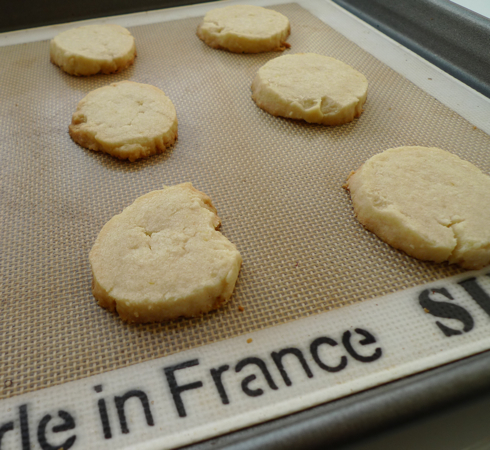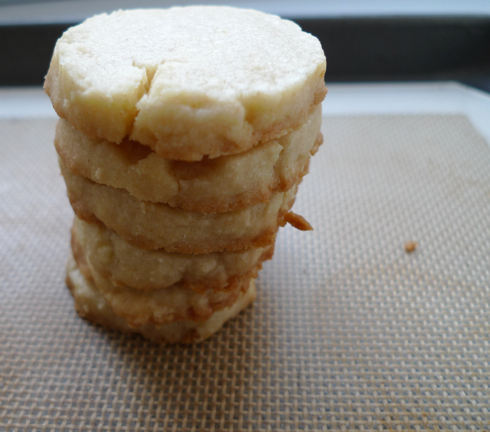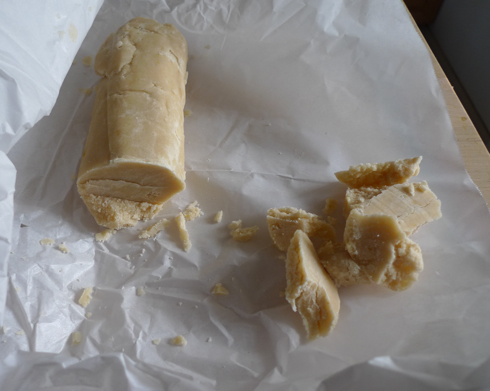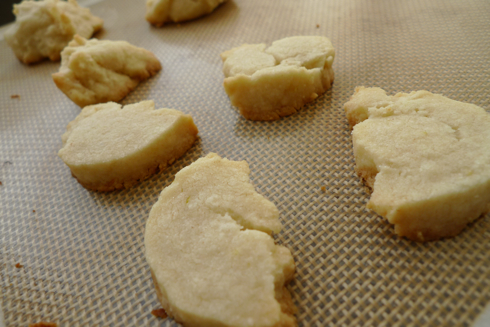
I haven’t been baking lately. Martha, my poor Kitchen Aid mixer has been a little bit lonely as my healthy lifestyle goals have reduced the amount of cookies coming out of my oven. I generally tend to use the excuse that my stove is unreliable, but the truth is, I’m afraid of baking a batch of wonderful cookies and not being able to control myself from eating the entire batch. Ah, the woes of a food lover trying to find balance.
Fortunately, I was invited to a party – which means that a host gift was in order – and Martha was finally put to good use for a batch of shortbread, one of my favorite cookies. I used to consume those stick shortbread in the red plaid packaging on a regular basis (Walkers), but baking your own buttery, crumbly shortbread is one of the easiest forays into baking there is, and well worth the (limited!) effort.

Traditional shortbread is made from one part white sugar, two parts butter and three parts oatmeal flour, but all I had on hand was some white flour, which tends to be the most commonly used today. Fortunately, If you stick to the ratio of 3 parts flour: 2 parts fat: 1 part sugar, you can be pretty adventurous – perhaps substituting some rice flour, or cornflour to vary the texture without risking the integrity of the final product.
You can also add in a number of mix ins – mini chocolate chips, flavoring such as almond or vanilla extract, citrus zest of all kind, pecans, dried fruit, or even use fresh herbs such as lavender or rosemary.
Other wonderful aspects of the shortbread cookie: The dough can be made in advance, rolled into a log, and stored in your refrigerator for several days so that you can slice a few cookies off when you want them. They also ship fairly well and are great as gifts. And the greatest part is that there are no eggs in the batter so you can eat it raw with abandon.

And don’t forget the cookie crumbles! You can bake those too! (The rejects make great quality control for the cook…) Now, to avoid broken slices, just let the log sit at room temperature for a few minutes before slicing, and use a warm knife. I’m impatient however, so some of my cookies turned out like this…

Shortbread
Makes about 2 dozen
1 1/2 cups all purpose flour
a pinch of kosher salt
2 sticks unsalted butter, softened
1/2 cup sugar
1 teaspoon vanilla extract
zest of 1/2 a lemon
1. In a bowl, mix flour and salt, and set aside.
2. In the bowl of a mixer, add softened butter and sugar, and beat on medium speed just until just smooth, about 2 minutes. Add vanilla extract, and lemon zest, and beat until combined. Set speed of mixer to low. Slowly add flour mixture to the mixer, and beat on a low speed until blended and just coming together.
3. Form dough into a logs, about 2 inches in diameter; wrap in parchment, and refrigerate 1 hour (or up to 3 days). If it’s still slightly crumbly, don’t worry, pack it tightly in the log, and it should firm up in the refrigerator. You can also freeze the dough for up to one month, and if frozen, let the log stand at room temperature for 10 minutes. 15 minutes before taking the dough out of the refrigerator, preheat the oven to 350 degrees Fahrenheit.
4. Remove shortbread from the fridge and remove parchment. Slice logs into 1/4-inch-thick rounds, and space about 1 inch apart on baking sheets lined with parchment or Sil-pat. Bake in the preheated oven until the edges are just slightly golden, about 12 minutes. Let cool to room temperature. (Cooling both allows the cookies to firm up so that they don’t fall apart, and will also help you to avoid burning your mouth on 350 degree butter.)
Cookies can be stored in an airtight container for up to 1 week, but believe me, they won’t last this long. They are also freezable, for up to a month.
Note: Recipe can easily be doubled, tripled, you name it. The main rule of thumb is to stick to the 3-2-1 ratio of flour to fat to sugar.


Oh my word! Those stacked shortbread cookies are spectacular. We always buy Pepperridge Farms shortbread cookies, which are great – but this will have to be a recipe for us to try soon.